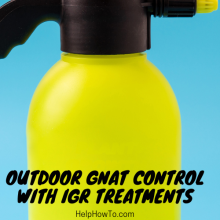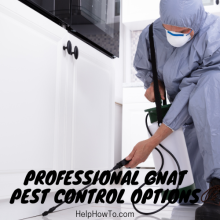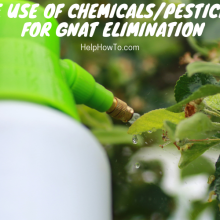Best Spray Insecticides For Gnat Infestations | HelpHowTo
Summary of Best Spray Insecticides For Gnat Infestations
When gnat infestations become severe, heavy-duty insecticide sprays may provide the solution. For indoor gnats, use fast-acting sprays with pyrethrins or pyrethroids, metered dispensers, or total release foggers. Outdoors, professional pyrethroids offer up to 4 weeks of residual control, while consumer yard sprays provide quicker knockdown. Treating breeding sites like standing water with insect growth regulators is crucial.
Key factors in choosing a gnat spray include active ingredients, concentration levels, residual length, and application method. While effective, insecticide sprays can harm bees, aquatic life, and cause irritation, so follow proper safety precautions. For complete control, integrate sprays with an IPM approach utilizing traps, larvicides, baits, and eliminating moisture sources to break the gnat life cycle and regain your yard and home.

Our Top 5 Recommended Indoor Genat Traps
Sick of pesky gnats invading your home? Discover the top 5 indoor gnat traps to banish these annoying insects for good! Our expert reviews reveal the most effective, easy-to-use traps. From powerful UV attractants to eco-friendly vinegar traps, we’ve thoroughly tested and ranked the best solutions. Check Now

Best Spray Insecticides for Bad Gnat Infestations
Gnats – those pesky little flies that seem to appear out of nowhere and swarm in thick clouds. While they don’t bite, their persistent presence is incredibly irritating and can make it miserable to enjoy being outside or even inside your own home. When gnat populations explode into a full-blown infestation, heavy-duty insecticide sprays may be the answer to finally regaining control.
Indoor Gnat Insecticide Sprays
For indoor gnat problems, fast-acting insecticide sprays provide knockdown of adult gnats quickly. Look for industrial-strength formulas with active ingredients like pyrethrins or pyrethroids. Concentrates that you mix with water allow you to cover larger areas. Metered insecticide dispensers are ideal for continuously treating problem areas like drains, garbage disposals, and under sinks where gnats breed.
If you need to fog an entire room or basement, total release insecticide foggers can penetrate everywhere gnats may be hiding. Ultra Low Volume (ULV) cold foggers disperse an insecticidal fog in even the tightest spaces. Thermal foggers use heat to better treat open areas like attics or basements. Just be sure to remove humans and pets first, and thoroughly ventilate after fogging before re-entering.
For a more environmentally-friendly approach, botanical insecticides derived from plants like chrysanthemums or essential oil-based sprays can be effective against gnats. These may be preferable for kitchens, around houseplants or vegetable gardens.
Outdoor Gnat Killer Sprays
To knock down massive outdoor gnat infestations on lawns, landscaping beds, patios and more, you’ll want professional-grade residual sprays. Look for products from pest control suppliers with active ingredients like bifenthrin, cypermethrin or other pyrethroids. These provide extended residual control for up to 4 weeks.
Consumer “yard guard” style aerosol sprays and trigger sprayers offer more economical gnat elimination around homes. Active ingredients like permethrin, prallethrin or piperonyl butoxide target and repel gnats and other flying insects. While providing quicker knockdown, they don’t last as long as pro products.
It’s also crucial to treat gnat breeding sites like standing water, moist shaded areas, clogged gutters or drainage ditches. Use a spray labeled for mosquito control that has an insect growth regulator like pyriproxyfen to stop larvae from developing.
Key Factors When Choosing an Insecticide
Beyond the active ingredients, other factors influence how well an insecticide spray will work on gnats. Concentration levels matter – higher percentages are more effective but may only be available in professional products. Look for longer residual lengths up to 4 weeks vs. 1 week.
Application method is also important. Aerosols are convenient for quick coverage of smaller areas. Pump sprayers or compressed air sprayers allow better liquid distribution over yards. Foggers may be needed for severe infestations in enclosed spaces.
Always check if a product is approved for indoor use if you plan to treat inside, or outdoor use if applying in your yard. Remove pets and children until the insecticide dries completely. Proper protective equipment like goggles and respirators are essential when applying insecticides.
Top Gnat Spray Recommendations
For dealing with out-of-control indoor gnat problems, Maxforce Fly Spot Pro delivers fast knockdown and long residual control. PT Cykick CE is another professional concentrate good for treating drains and breeding areas.Top Gnat Spray Recommendations
For outdoor use, product like Bifen IT, Talstar, and Suspend are pro-grade pyrethroids labeled for controlling gnats and mosquitoes around homes. They provide up to 4 weeks of residual control. Eco-friendly options include GardenTech Sevin and Safer Brand Insecticide.
It’s smart to rotate between different active ingredients and modes of action to prevent gnats from developing resistance to any single product.
Downsides to Insecticide Sprays
While highly effective, broad-spectrum insecticide sprays do come with some downsides. Pyrethroids can be toxic to bees and beneficial insects like lacewings or ladybugs. Check labels for bee advisories.
Most insecticides have some degree of toxicity to aquatic life as well. Be very cautious about overspray or runoff contaminating waterways. Certain formulas may not be approved for use around vegetable gardens.
Pyrethroid sprays may cause eye, skin or respiratory irritation for some individuals. Always carefully follow safety precautions on product labels. Ensure proper ventilation if using indoors. Bathe pets after treatment if exposed.
Integrated Pest Management
For complete control, insecticide sprays are just one part of an integrated pest management (IPM) approach for gnats. Cultural practices like eliminating sources of standing water around homes and yards remove gnat breeding grounds. Installing fans or air curtains disrupts gnat flight patterns.
Sticky traps, UV light traps or bug zappers capture adult gnats. Larvicide products like BTI briquets added to standing water prevent larvae from developing into gnats. Incorporating baits like Golden Malrin Fly Bait with the sprays can be very effective.
With an IPM program using multiple control methods, homeowners can systematically get rid of even severe gnat infestations while limiting the need for repeated heavy insecticide applications.
Concluson
Dealing with clouds of annoying gnats doesn’t have to mean living in misery. While it takes persistence, a combination of heavy-duty residual insecticide sprays targeting adult gnats supplemented with other IPM methods can effectively break the gnat life cycle. By striking at all stages and depriving gnats of breeding sources, you can regain your yard and home from these pesky intruders.

Our Top 5 Recommended Indoor Genat Traps
Sick of pesky gnats invading your home? Discover the top 5 indoor gnat traps to banish these annoying insects for good! Our expert reviews reveal the most effective, easy-to-use traps. From powerful UV attractants to eco-friendly vinegar traps, we’ve thoroughly tested and ranked the best solutions. Check Now
FAQs and Answers
How long does it take for insecticide sprays to start working on gnats?
Most insecticide sprays will start working on gnats quite quickly, providing an initial knockdown of adult gnats within a few hours to a day after application.
The speed of the knockdown effect depends on the active ingredient and formulation of the product used. Sprays containing fast-acting ingredients like pyrethrins or pyrethroids tend to work the fastest, often killing gnats on contact or within 30 minutes to an hour.
Water-based insecticide sprays usually take a bit longer to take full effect compared to aerosols or oil-based formulas that suffocate insects rapidly. But you should still see a noticeable reduction in adult gnat numbers within 4-6 hours as the product starts working.
Insect growth regulators and larvicides in some gnat sprays prevent future generations, but they don’t impact the existing adult population as quickly as neurotoxic active ingredients.
So while you get very rapid knockdown initially, it can take a week or more of reapplying residual sprays to fully break the gnat lifecycle and completely eliminate an infestation. Following label instructions on retreatment intervals is key.
Are there any restrictions on using gnat insecticide sprays around edible plants/crops?
Yes, there are some important restrictions and precautions to take when using insecticide sprays for gnats around edible plants and crops:
- Look for products specifically labeled for use on edibles/vegetables. Many synthetic insecticides will have warnings against applying them on plants grown for food/feed.
- Pay close attention to pre-harvest intervals (PHI). This is the required number of days you must wait between spraying and harvesting the edible portions to allow residues to dissipate to safe levels.
- Some botanical or essential oil-based insecticide sprays derived from plants are generally regarded as safer for use on edible crops close to harvest when used as directed.
- Avoid spraying during bloom periods when bees are active, as insecticides can be hazardous to pollinators.
- Use caution around leafy greens, herbs and crops where the entire plant is consumed to prevent insecticide residues.
- Always thoroughly wash and clean any edible portions of the plant before consuming after applying insecticide sprays, even those allowed for use on crops.
- Consider using insecticide baits or traps instead of sprays to avoid contacting edible plants directly.
Following product label instructions is crucial to ensure proper use and adherence to plant-back, pre-harvest and other intervals when using gnat sprays around gardens and on food crops.
How often should I re-apply gnat insecticide sprays?
The frequency for reapplying gnat insecticide sprays depends on several factors:
Active Ingredient Residual
Most synthetic pyrethroid insecticides like bifenthrin, cyfluthrin, or lambda-cyhalothrin provide 2-4 weeks of residual control against gnats when sprayed outdoors. Shorter residuals of 1-2 weeks are typical for indoor applications. Botanical or essential oil sprays may only last 5-7 days before reapplication is needed.
Life Cycle Disruption
If the spray just kills adult gnats but doesn’t have an insect growth regulator or larvicidal properties, you’ll need to reapply every 7-10 days to disrupt the next generation before it emerges.
Inspection & Monitoring
Closely inspect for new gnat activity and reapply sprays once you start seeing an increase in populations. Don’t wait until there’s another full-blown infestation.
Environmental Factors
Heavy rainfall, sprinklers, or intense sunlight can degrade insecticide residues faster, necessitating more frequent reapplications on a weekly basis.
Most product labels will provide a recommended reapplication interval, typically between 7-30 days depending on the product. Following those guidelines while monitoring gnat levels is advised for consistent control until the infestation is eliminated.
Can gnat insecticide sprays be used indoors and outdoors?
Most gnat insecticide sprays are formulated specifically for either indoor or outdoor use, and it’s important to use them as labeled. However, there are some products that can be used in both settings with proper precautions.
Indoor-Only Sprays
Many total-release aerosol foggers or spray products containing ingredients like pyrethrins, piperonyl butoxide (PBO), or prallethrin are designed solely for indoor use against flying insects. Using these products outdoors can lead to dissipation and lack of effectiveness.
Outdoor-Only Sprays
On the other hand, sprays with pyrethroids like bifenthrin, cyfluthrin, deltamethrin at higher concentration levels are typically too harsh for indoor residential use. These are made for outdoor perimeter, landscaping, and lawn applications.
Dual Indoor/Outdoor Use
Some insecticide concentrates once diluted can be applied both indoors and out, as long as all label directions are followed carefully. Examples are products containing pyrethrins + PBO or pyriproxyfen that are labeled for homes, gardens, and landscapes.
Safety Considerations
If using the same product inside and out, be very cautious about fumes and ventilation indoors. Remove children and pets first. Take precautions against touching surfaces until dried. Consider lower indoor concentrated rates.
The label directions are the ultimate guide, specifying if a particular gnat insecticide spray is approved for interior, exterior or can be used in both settings with proper safety measures in place.
Do gnat sprays work on other flying insect pests too?
Yes, most insecticide sprays labeled for controlling gnats will also be effective against a variety of other flying insect pests around homes and yards. The key active ingredients in gnat sprays have broad-spectrum abilities.
Pyrethrins/Pyrethroids
Products containing natural pyrethrins or synthetic pyrethroid insecticides like permethrin, bifenthrin, cyfluthrin don’t just kill gnats – they work on mosquitoes, flies, moths, wasps and more. Their neurotoxic modes of action impact most flying insects.
Botanical Insecticides
Sprays using botanicals derived from chrysanthemum flowers or essential oils like rosemary, peppermint or thyme oils are effective broad-spectrum insecticides for multiple flying and crawling bug species.
Insect Growth Regulators
While not immediately killing adults, IGRs like pyriproxyfen disrupt the life cycles of gnats, mosquitoes, fungus gnats and other fly pests by preventing juvenile stages from maturing.
Always check product labels, as many will list the array of insect pests controlled, including flies, mosquitoes, moths, wasps, beetles and more alongside gnats. Using a gnat spray with residual activity outdoors can help reduce populations of flies, no-see-ums and other nuisance pests too.
The versatility of most gnat insecticide active ingredients make them a good choice for controlling mixed infestations of multiple flying insect species around homes and landscapes.

Our Top 5 Recommended Indoor Genat Traps
Sick of pesky gnats invading your home? Discover the top 5 indoor gnat traps to banish these annoying insects for good! Our expert reviews reveal the most effective, easy-to-use traps. From powerful UV attractants to eco-friendly vinegar traps, we’ve thoroughly tested and ranked the best solutions. Check Now





